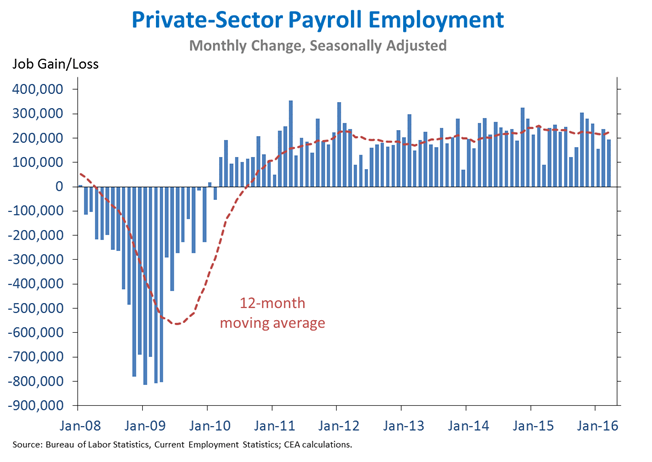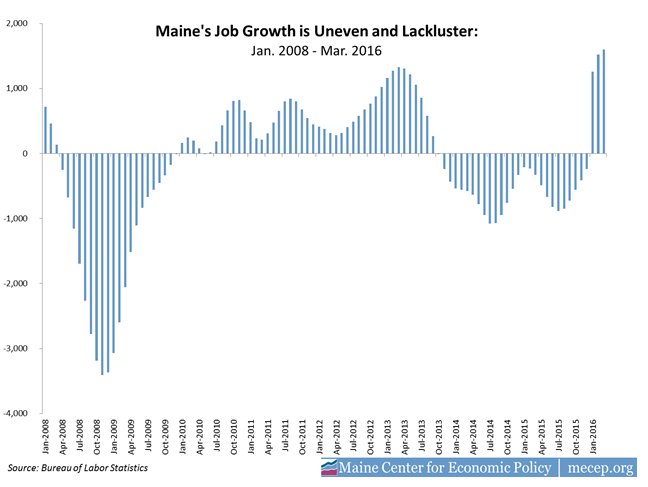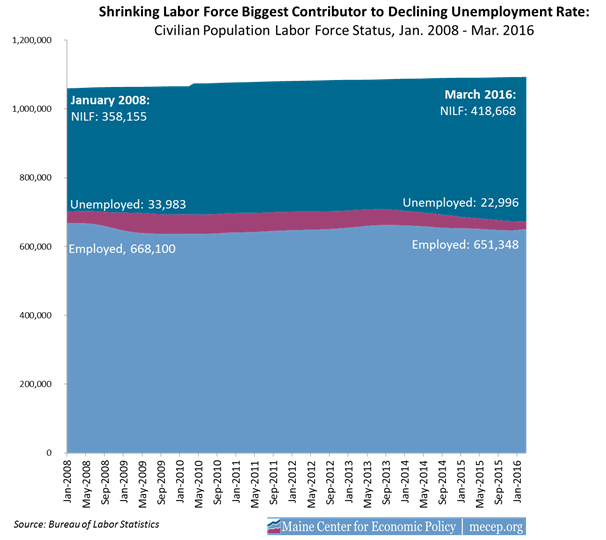The latest State & Local Area Unemployment Statistics are in from the Bureau of Labor Statistics (BLS), and the difference between the Maine and national economies couldn’t be clearer. While the White House announced its 73rd month of straight job growth, Maine still hasn’t recovered all the jobs lost during the recession.
Since 2010, the number of people employed in the private sector in the US has risen by 14.4 million (6% of the adult civilian population), the job growth in Maine in Maine over the period is 14,650 (1.4%). As anemic as Maine’s job growth looks, the situation is even worse when comparisons are pushed further back.
The US recovered the 8.7 million jobs lost since December 2007 by early 2010, but Maine still has 16,000 fewer people working today than it did in December 2007. In December 2006, Maine actually had 21,000 more people employed than we do today.

National Monthly Job Growth, whitehouse.gov

Maine’s job growth has not only been more sluggish than the nation as a whole, but it’s been uneven. During 2014 and 2015, hundreds of people left the Maine employment rolls every month, even as national the jobs situation improved robustly.
But isn’t Maine’s unemployment rate at a record low? Technically, yes. But it’s important to know how the technocrats calculate unemployment. They narrowly define unemployed individuals as those who looked for work over the past four weeks. They do not consider people who are discouraged or looking intermittently “unemployed” in the official count. Instead, they classify them as “not in the labor force.” An examination of Maine’s civilian population over the 2008-16 period shows that while the unemployment rate is lower, total employment is also down. The number of people not counted in the labor force has increased over this period. Some of those are retirees, but many are not. Working-aged men (aged 18-65) are one of the fastest growing components of the population not in the labor force.

Three factors are major contributors to the difference in the national and state outlooks:
- Different fiscal policies. While the Obama Administration began with a massive fiscal stimulus package, the LePage administration has focused on reducing state government spending wherever possible. Not only have LePage tax cuts eaten away at state revenues and reduced the state’s ability to plan for the future, the administration has rejected billions of dollars in federal money.
- Different health care decisions. The Affordable Care Act, and the enrollment nationally of tens of millions of people in health insurance plans created new jobs in the healthcare sector and improved the health of workers (illness is the number one reason for labor force non-participation among those under 65). Meanwhile, Maine has rejected federal funding to expand MaineCare. As a result, Maine missed out on more than 4,000 jobs and has actually fallen behind in health care coverage, most tragically among children.
- Different demographics. Not only is Maine’s population the oldest in the nation, but it is also the “whitest” as defined by the Census Bureau. An aging population reduces the share of the population which is able to work (even as those of traditional retirement age continue to work longer). Further, the lack of diversity in Maine exacerbates our aging population. People of color and immigrants tend to have larger families, and states with more representative demographics have a lower median age.
- Inability to attract new people. Between 2008 and 2015 (the most recent data available), the US population grew by 17 million (5.7%), through a combination of births outpacing deaths and immigration from overseas. Maine’s population only grew by 13,000 (1.0%). In 2015, the state’s population actually declined slightly –for the first time in 145 years. Without the ability to attract new workers and their families (the LePage administration has consistently manifested hostile policies toward immigrants), Maine’s potential labor force will shrink every year, contracting the economy further.
Maine lawmakers have the tools to reverse these trends. The bipartisan 2015 budget agreement, passed over Gov. LePage’s veto, made a good start at restoring the progressivity of Maine’s tax code, but revenue is still well below where it needs to be to adequately fund services like schools. This week the legislature voted for a sixth time to accept Medicaid funding in the final weeks of the 2016 session, but face a sixth LePage veto. Most policymakers recognize Maine’s demographic challenges, and the need to welcome new Mainers from other states and overseas is gathering acceptance. The crucial next steps are to boost these efforts with growth-oriented policies.



